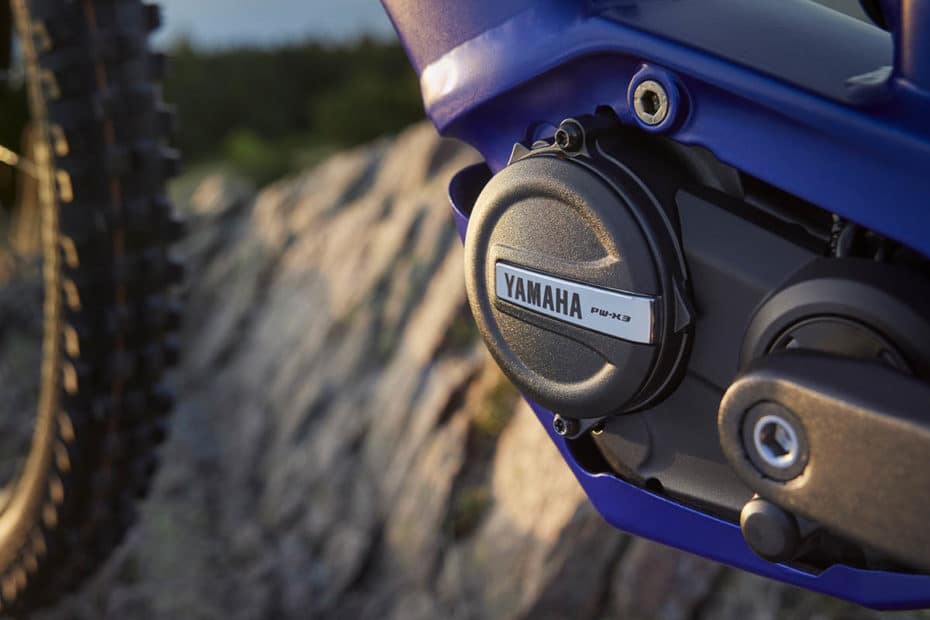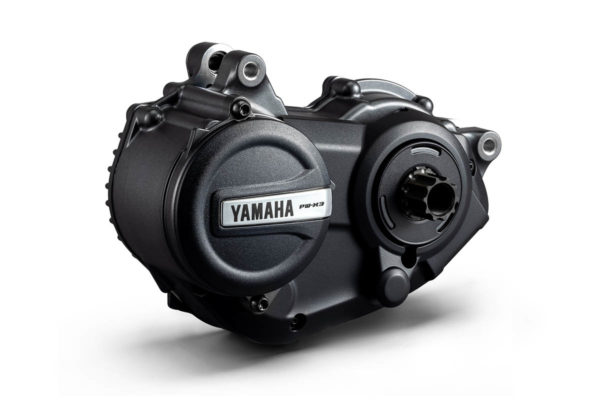In the hustle and bustle surrounding the new development stage of the Bosch drive system, it almost went unnoticed that Yamaha is also starting the 2022 season with a new motor. While much of the focus at the German competition is on the improved software, the Japanese have concentrated more on the hardware. In addition to the new unit, the PW-X3, there is also a new control unit, the Interface-X.
1. Yamaha PW-X3: When less is more
2. Yamaha Interface X: Minimalism as a guiding principle
3. Yamaha External Crossover 400: New mid-range battery pack
1. Yamaha PW-X3: When less is more
Progress can generally be measured in numbers. In this respect, the PW-X3 is convincing. Lighter and smaller is the short version. With just over three kilograms, the predecessor model PW-X2 was already one of the lighter ones of its kind. In comparison, Yamaha has been able to do without about ten percent of this weight. In the end, the manufacturer now ends up with 2.75 kilograms and thus saves about 300 grams.
The weight advantage goes hand in hand with smaller dimensions. Here, the saving compared to the previous standard is even greater, at around 20 per cent. Of course, you only benefit from this indirectly. Primarily, it opens up new possibilities for bicycle manufacturers when it comes to integrating the motors. Put simply, in future they will have more space available to deal more flexibly with the bottom bracket height or to harmonise the desired frame geometry with suspension components more easily.
In terms of riding feel, you benefit in any case. On the one hand, the lower weight and the more compact design automatically provide more agility and manoeuvrability. On the other hand, you also benefit from the increased torque of the PW-X3. With the maximum available 85 Newton metres, you can get off the ground quickly and have good arguments even on very steep climbs.
Riding like on a conventional bike
Yamaha’s claim for itself and the new motor is to provide a riding experience that is as natural as possible. In the language of the manufacturer, this is called the Pure Ride concept. Behind this is the approach of an electric assistance that responds to your pedalling directly from the first load. The power is supposed to develop immediately and enable you to accelerate quickly at the start. To make sure this happens in the same way, Yamaha has shortened the detent mechanism of the idle travel, called Backlash.
The low Q-factor, which is also supported by the new PW-X3, fits this rather sporty orientation. As with the existing PW-X drive units, the axle length of the motor is exactly 128 millimetres. Consequently, the distance between the pedals can be very small. Values around 150 millimetres are, for example, typical for the cranks of well-known manufacturers in the road bike sector. With the cranks mounted, an ebike with a PW-X3 will not be far off. Usually, distances in this range are perceived as “natural” when pedalling and are also considered very efficient in terms of power transmission.
Fewer driving modes than before
The motor’s power can be accessed within four assistance levels. Compared to the past, the Eco+ and the Extra Power Mode EXPW have been dropped. Eco, Standard and High Performance modes can still be selected. A fourth mode, Automatic, has been added. This changes to one of the three modes mentioned, depending on the route profile and the road surface. According to Yamaha, the support will be lower on flat roads and increase with steeper climbs.
Technical data of the Yamaha PW-X3
- Rated voltage: 36 V
- Rated power: 250 W
- Max. assisted speed: 25 km/h
- Max. torque: 85 Nm
- Weight: 2.75 kg
- Assistance modes: Eco mode / Standard mode / High-performance mode / Automatic mode, which selects the appropriate mode depending on the riding situation
2. Yamaha Interface X: Minimalism as a guiding principle
You can control the PW-X3 via the new Interface X. This is a display with a decidedly minimalist design. It can be attached to the stem below the Ahead cap. Two discreet LED bars in different colours show the selected support level and the remaining capacity of the battery in four steps. There are two buttons for switching on and off and for activating the high beam – and that’s it. Stop, not correct. There is also a USB port. Experts can use it to connect cables for system diagnostics. The socket also serves as a power supply, of course.
Located further out on the handlebars is the corresponding control unit. Two ergonomic buttons mounted on a rocker are all you get for control. Similar units from Shimano or Giant show that this is perfectly adequate.
Extremely communicative
Communication on Interface X works with Bluetooth® Low Energy and ANT+™ technologies. The first standard is used to exchange information between the ebike and smartphone with the help of corresponding apps. Via the ANT+™ interface, you can connect bike computers and navigation devices from Garmin, SIGMA and Echowell to the drive system.
The Interface X is only compatible with pedelecs from the 2022 season.
Technical data of the Interface X
- Type of display: Multi-colour LED
- Power supply: 1,200 mA (with PW-X3) 1,000 mA (with other drive units)
- Connectivity: Bluetooth® Low Energy Technology, ANT+™
- Permanently on functions: Battery capacity, support mode
- Freely selectable functions additionally available via smartphone apps or connected devices.
- ANT+™ profiles:
- LEV : Light Electric Vehicle
- S&C : Speed & Cadence
- PWR : Bicycle Power
3. Yamaha External Crossover 400: New mid-range battery pack
In parallel with the PW-X3, a new detachable frame battery will also be released. With it, Yamaha completes its EX battery range with a model that offers a capacity of 400 watt hours. Those of you who can cope with such a size in everyday use and prefer to take their battery out of the bike for charging will be pleased with this solution.
Technical data of the External Crossover 400
- Voltage: 36.5 V
- Capacity: 11 Ah
- Rated power: 410 Wh
- Weight: 2.8 kg
- Charging time: approx. 3.5 hours
Pictures: Yamaha Motor Co, Ltd.








Hi there,
Has anyone in the UK been able to link the Interface-X to any app on the phone?
I’ve talked to Haibike and that said e-connect was discontinued in 2021.
They suggested a different app called e-sync, but it doesn’t recognise the bike.
Thanks in advance!
Nat
Hi Nat,
As far as we know, the lack of app support is absolutely an issue with Yamaha. The company probably knows that e-sync doesn’t really work and is working on an alternative. At the moment, only komoot recognises the Yamaha system. However, you don’t get any data about the support mode, the remaining range, the battery status and the like. Of course, the focus is clearly on navigation. We are in contact with Yamaha. As soon as they come up with a real solution, we hope to let you know on our blog.
Cheers, Matthias
yes I confirm, the e-sync app recognizes the yamaha device but that’s all. will not get any data. do you have any experience with connecting a garmin 530? thanks for the info.
Hello Zdenek,
Thanks for your comment on this. Regarding the Garmin 530, unfortunately we don’t have any experience with that being used with a Yamaha ebike drive system.
Cheers, Matthias
Is there anyway of changing the max speed from 16 to 20 for when I go abroad please
Hello,
Unfortunately there is no such option. Otherwise, the bicycle manufacturers would not really be able to ensure that the ebike complies with the specifications of the country or region to which it is delivered.
Cheers, Matthias
Yamaha interface X it’s working very well with Sigma Rox 11.1. Very easy to recognize my Yamaha YDX 7, Pwx3 motor.
Hi,
Thank-you, we appreciate.
Cheers,
Luca
I have the PW X3 in my Goant Trance Adv e+1 and to date never missed a beat, off the mark power is instant, climbing steep techinal trails becomes a dream with minimal effort and really keep the rider in absolute control. Nothing but perfect for me. The only downfall in Australia is that they are limited to 25klm/h so on flat straights your are our paced be analog bikes. But bring on those hills and it comes into its own. On single trails it’s also awesome, you slow down to take a corner and when your back on – the power is instant and your back up to speed in seconds. I could go on and on..love
Hello Scott,
Thanks for your impressions. For sure interesting to read for people who want to know about this drive. Sounds, like biking in Australia has more in common with Europe than expected 😉
Cheers, Matthias
Hi,
are you sure, that Yamaha External Crossover 400: New mid-range battery pack is compatible or fit for new YAMAHA PW-X3. Because I bought HAIBAIK Alltrail 7 equiped with that motor, bat I have a problem with any extender for this bike. Nowhere thay can buy….
Hello Vladimir,
Tricky topic. Yamaha introduced the battery in 2021 together with the then new PW-X3. However, we have not yet come across a model from a bicycle manufacturer that has this battery installed as standard. We also do not know of a corresponding individual adapter. Presumably, both are compatible with each other. However, no manufacturer has ordered this battery from Yamaha.
Cheers, Matthias
deseo saber precios y dónde se puede comprar, también quien suple cualquier repuestos y accesorios de la misma ?, muchas gracias…
Hola José,
El motor no se puede comprar, Yamaha lo suministra directamente a los fabricantes de bicicletas. En nuestra tienda puede encontrar, por ejemplo, piezas de los accesorios para accionamientos Yamaha y baterías del fabricante. Adjunto los enlaces de nuestra tienda española y de la alemana aquí. La tienda española es el mejor lugar para encontrar lo que buscas, pero la tienda alemana tiene más artículos.
https://www.ebike24.es/recambios-e-bike-yamaha
https://www.ebike24.es/baterias-yamaha
https://www.elektrofahrrad24.de/yamaha-ersatzteile-e-bike
https://www.elektrofahrrad24.de/yamaha-e-bike-akkus
Saludos cordiales, Matthias